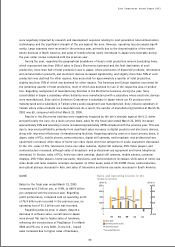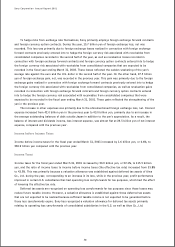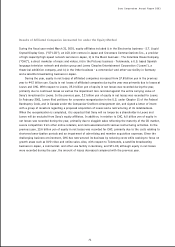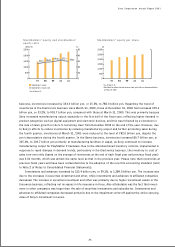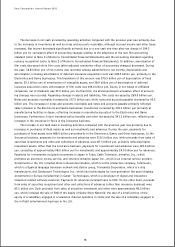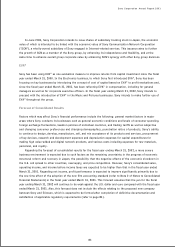Sony 2001 Annual Report Download - page 75
Download and view the complete annual report
Please find page 75 of the 2001 Sony annual report below. You can navigate through the pages in the report by either clicking on the pages listed below, or by using the keyword search tool below to find specific information within the annual report.
Sony Corporation Annual Report 2001
73
LIQUIDITY AND CAPITAL RESOURCES
Finance and Liquidity Management
Sony’s financial policy is to assure adequate financing and liquidity for its operations and to maintain the
strength of its balance sheet.
Regarding types and maturities of funding, it is a basic policy of Sony to utilize long-term debt financing and
equity financing/equity-linked bond financing as needed, for long-term funding requirements such as for invest-
ments, and to utilize short-term debt financing for short-term funding requirements. Regarding long-term
funding, in September 2000 Sony Corporation issued a total of 150.0 billion yen of notes aimed at financing
capital expenditures for its manufacturing equipment for semiconductors, using a shelf registration statement for
use in the Japanese market, with respect to 300 billion yen of notes, and in October 2000 also issued 12.0 billion
yen of bonds with detachable warrants for the purpose of stock-price linked incentive compensation.
In order to meet funding requirements in each area, Sony maintains in Japan 300 billion yen of Japanese
commercial paper (“CP”) issuance capacity at Sony Corporation. Sony issued 50 billion yen of CP in June 2000
and redeemed in October 2000 to fund a temporary increase of working capital. Moreover, Sony maintains U.S.
CP programs of 6 billion U.S. dollars at its finance subsidiary in the U.S., and also maintains U.S. CP programs of 1
billion U.S. dollars and Euro CP programs of 0.5 billion U.S. dollars at its finance subsidiary in the United Kingdom.
During the fiscal year ended March 31, 2001, peak month-end outstanding balances were 156.6 billion yen at a
finance subsidiary in the U.S. and 58.4 billion yen at a finance subsidiary in the United Kingdom. At March 31,
2001, the total outstanding balance of CP programs was 117.3 billion yen. In addition to the aforementioned CP
programs, Sony maintains a 3 billion U.S. dollar medium term note (“MTN”) program targeted for investors in the
U.S. and a 2 billion U.S. dollar Euro MTN program at a finance subsidiary in the U.S., and also maintains 1 billion
U.S. dollar and 0.5 billion U.S. dollar Euro MTN programs at finance subsidiaries in the United Kingdom and
Netherlands, respectively. At March 31, 2001, the total outstanding balance of MTN programs was 79.3 billion yen.
Regarding the maintenance of liquidity, it is a basic policy of Sony that it will keep total liquid assets equal
to at least 80% of the sum of the amount of the largest expected monthly gross sales and the amount of the
largest expected monthly debt redemption during the fiscal year. Liquid assets consist of cash and cash equiva-
lents, time deposits, and marketable securities. In addition to these, Sony also includes committed lines as liquid
assets because funds are available from such lines during the period of the contracts. Sony has contracts for
committed lines with banks in a total amount of approximately 430 billion yen at March 31, 2001. All of those
contracts are short-term, expiring in less than one year. As a principal policy, Sony selects banks rated “C” or
above in Moody’s Bank Financial Strength ratings for its contracts for committed lines, and enters into contracts
with banks rated “A” or “B” with respect to more than 70% of the total amount. The policy and figures in this
paragraph exclude Sony Life Insurance Co., Ltd., Sony Assurance Inc., and Aiwa Co., Ltd., each of whose liquidity
is managed separately from the remainder of Sony.


